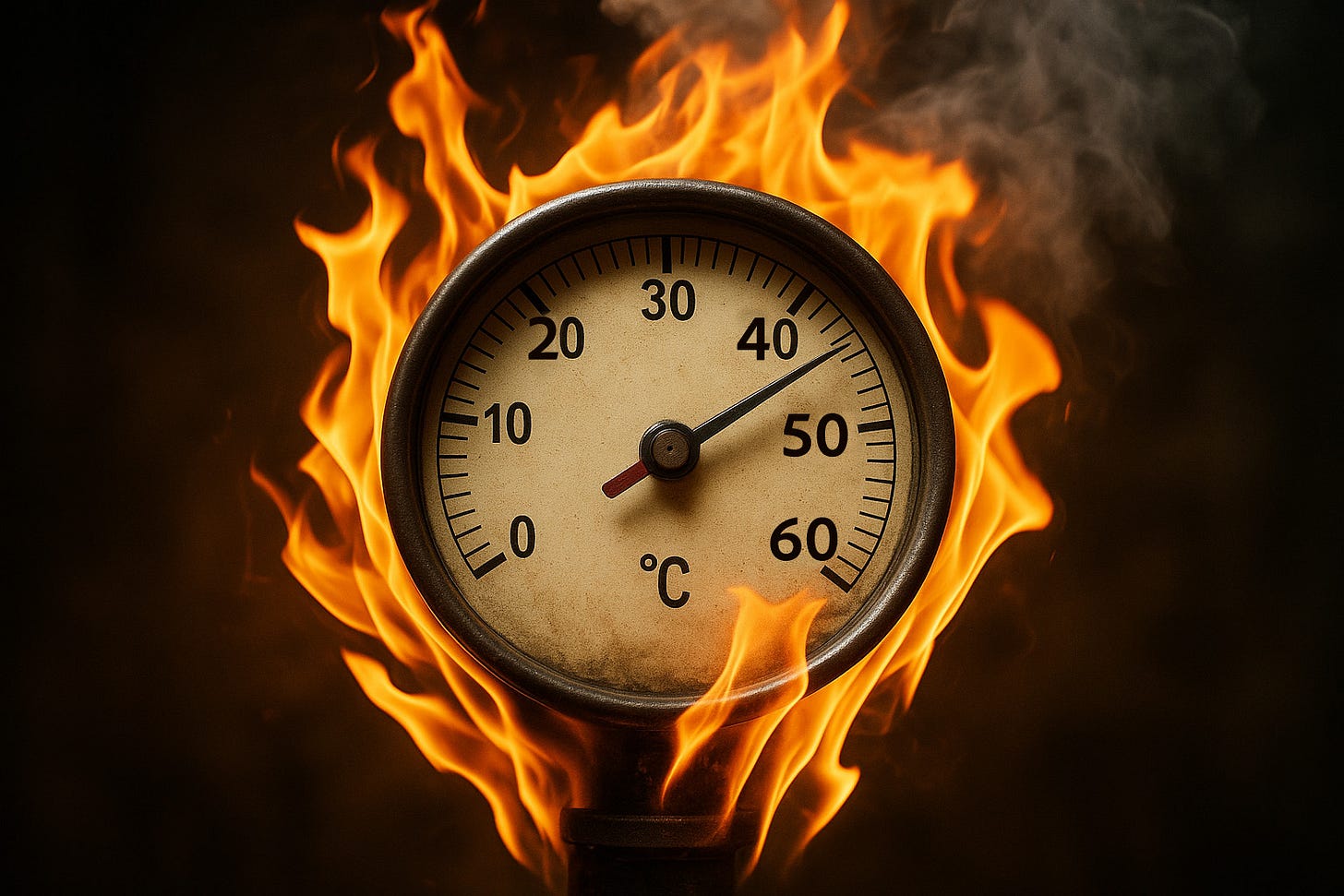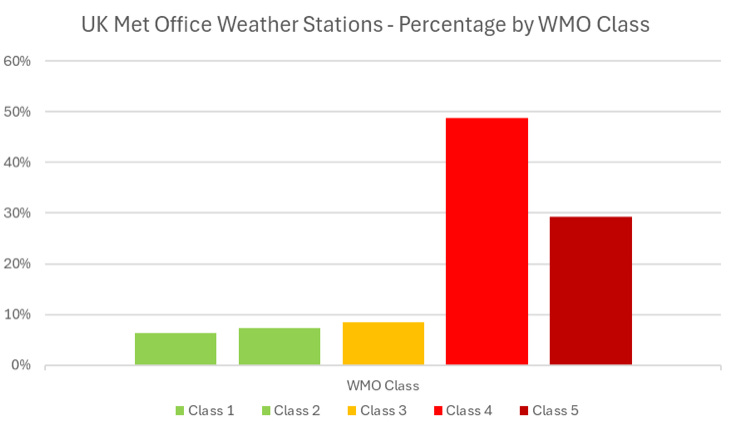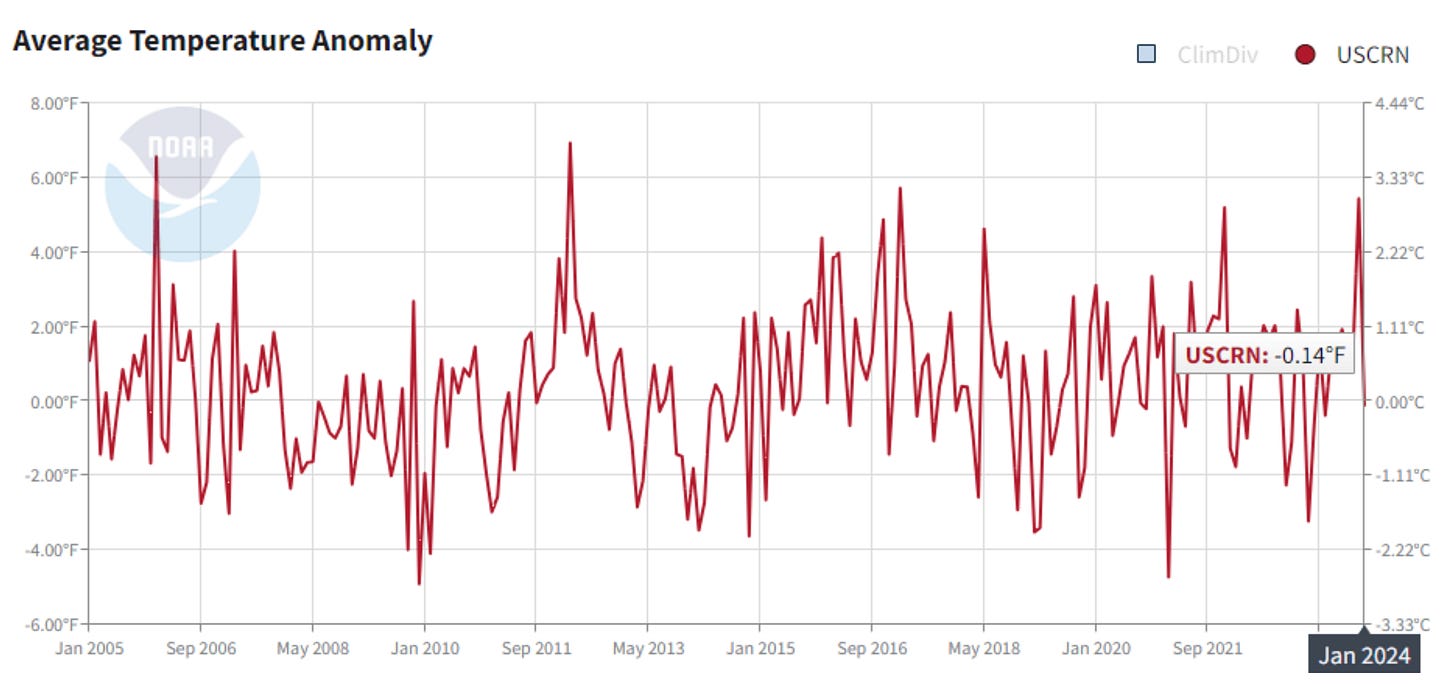Unmasking Poor Quality UK Met Office Data
Why UK Temperature Data Deserves a Closer Look
Many people are concerned about climate change. This is understandable, we see headlines, hear reports, and are told that global temperatures are soaring. This is apparently a climate emergency that demands urgent action, such as the UK’s Net Zero project.
However, what if the foundation of these alarming claims, the temperature data itself, is unreliable?
Recent investigations, primarily by citizen journalists using Freedom of Information (FOI) requests, have revealed significant issues with the UK Met Office's temperature measuring network. These findings suggest that much of the data used to report rising temperatures and declare new records is of poor quality, potentially inflated by artificial heat sources, or even entirely invented. This raises critical questions about the scientific rigour behind the narratives driving billion-pound Net Zero policies and public anxiety.
Thanks to Ray Sanders, Chris Morrison and Paul Homewood, for their diligent work exposing this state sponsored misinformation. I provide detailed references to their work at the end of this article.
Rather than just summarise the issues they found, I have suggested several actions which you could take to help prevent this problem continuing. This includes a template letter which you can use to write to your MP to ask them to intervene.
Key Findings
Here are some key findings that if you hadn’t come across before should prove shocking.
Pervasive Poor Siting. Nearly 8 out of 10 (77.9%) of the Met Office’s 380 UK temperature stations are classified by international standards from the World Meteorological Organisation (WMO) as 'junk' or 'near junk' (Class 4 and 5). This means their readings could be off by up to 5°C. These stations are often located near artificial heat sources like buildings, concrete, airports, and car parks.
Invented Data from Non-Existent Stations. The Met Office has been publishing temperature data from over 100 non-existent or defunct weather stations, often for periods long after they ceased operation. This “ghost data” is apparently estimated using regression analysis from "well-correlated neighbouring stations”. However, there are even instances where these neighbouring stations do not exist themselves!
Internal Ratings vs. International Standards. Despite the widespread issues under WMO standards, the Met Office internally rates over 9 out of 10 (90%) of its stations as 'Excellent,' 'Good,' or 'Satisfactory'.
Record Temperatures from Flawed Sites. Many of the highly publicised record high temperatures and extremes reported by the Met Office, often cited as evidence of a climate emergency, are derived from these poorly-sited Class 4 and 5 stations, sometimes even from "Unsatisfactory" sites.
Understanding the Flaws in UK Temperature Data
The precision with which the Met Office reports temperature increases (sometimes to a hundredth of a degree Celsius) stands in stark contrast to the inherent uncertainties within its measuring network. A deeper dive into these problems shows why a healthy scepticism towards the official narrative is absolutely essential.
The Problem of Poor Siting - Heat Corruptions Everywhere
The World Meteorological Organisation (WMO) employs the Commission for Instruments and Methods of Observation (CIMO) classification system for weather stations, where each Class is defined as follows:
Ideal siting, open terrain, flat surface, minimal artificial influence - uncertainty ≤ 0.2°C
Minor issues (e.g., slight slope or small obstacles) - uncertainty ≤ 0.5°C
Moderate issues (e.g., nearby buildings/trees, uneven ground) - uncertainty ≤ 1.0°C
Significant issues (e.g., urban settings, nearby roads, obstructions) - uncertainty ≤ 2.0°C
Poor siting—data not suitable for climate trend analysis - uncertainty > 2.0°C
This graph shows how UK Met Office weather stations are scored based on this system:
It demonstrates that a total of 77.9% of stations could be producing 'junk' or 'near junk' readings! This is bad enough, but though the uncertainties could mean temperatures being seen as artificially low, in the majority of cases the bias is for increased temperatures. This is easy to understand given locations in or near car parks, airports, domestic gardens, sewage and water treatment plants, electricity sub-stations and solar farms.
It is clear that “hottest ever records” would be greatly reduced if the MetOffice limited themselves to only class 1 and class 2 weather stations. Poor quality stations are known to add an upward bias of between 2-5°C. Many records come from low-quality stations with high uncertainties. Restricting to class 1 and class 2 would eliminate data from dozens of stations that tend to be more prone to urban heat island (UHI) effects. Here are some examples of Class 5 station records highlighted by the Daily Sceptic that would have been excluded:
St James’s Park and Northolt airport reported over 40°C on 19th July 2022 .
Cambridge Botanic Gardens for a previous UK record in 2019.
Castlederg (also classed by MetOffice as unsatisfactory! ) for the highest daily maximum temperature in Northern Ireland.
Achfary for the highest January monthly temperature last year and another record in December 2019.
To be fair to the Met Office, Chris Morrison in the Daily Sceptic does acknowledge:
The Met Office is between a rock and a hard place with these surface temperature measurements. Many of its long-standing stations have been encroached by urbanisation and corruptions seem to have become endemic across the entire system.
However, even newly established stations are poor quality. Over eight in ten of the 113 temperature stations opened in the last 30 years were deliberately or carelessly sited in Class 4 and 5 locations. This trend continues, with eight out of the 13 stations opened in the last five years also being at similar junk sites.
The Mystery of the "Invented" Data
Perhaps even more concerning than poor siting is the revelation that the Met Office has been publishing temperature data for locations where no operational weather station exists. This practice has been highlighted by citizen investigator Ray Sanders through Freedom of Information (FOI) requests. Sanders discovered that:
103 out of 302 sites supplying temperature averages in one Met Office public database were "non-existent". In another historical database of 37 stations, 19% (7 stations) are closed or do not exist but continue to report data.
Several stations either provide data outside their operation range, one even 10 years prior to becoming operational.
The Met Office (and NASA) have also made many changes to historical temperature data, with the Met Office's HadCRUT dataset adding about 30% extra warming to recent global temperatures over the last decade, effectively removing a "pause" in warming around 2000-2014.
The shift to automated, electrically-operated thermometers led to the closure of many cooler, rural sites in favour of urbanised locations due to electricity supply needs. This explains why newer stations (44 out of 58 according to Paul Homewood) are low quality but not why the Met Office hides the key information from the public.
These issues raise fundamental questions about the reliability of long-term temperature trends.
The Met Office defends itself by stating they use regression analysis to estimate data for non-existent stations, based on data from well-correlated neighbouring stations. However, this explanation falls short when, for instance, the supposed well-correlated stations used for some were themselves non-existent.
The Met Office has been criticised for a lack of transparency, declining to provide details on how data for these 103 non-existent sites was derived. After "massive social media publicity," the Met Office quietly renamed its "UK climate averages" page to "Location-specific long-term averages" and removed individual coordinates for these "imaginary sites," without public announcement. This does not sound like the action of an open accountable public body.
I take my hat off to Ray Sanders but I have to ask - why is something so important the domain of citizen journalists? Why isn’t this splashed all over the main stream media?
Politicisation and Eroding Trust
All this begs two obvious questions:
Why is the MetOffice not using WMO standards and only high quality weather stations?
Why don’t they publicise the limitations in their data?
The only answer that makes any sense is that the Met Office along with their publicists at the BBC and elsewhere need to maintain the narrative that temperatures are continuously rising dangerously. Why? To justify policies like Net Zero which in practice raise electricity prices and kill jobs. The fact that the Met Office, the BBC and others are engaged in a political campaign is something that should trouble everyone. These organisations have a duty to report the data fairly and without bias. They are failing in this duty.
However, on uncensored social media we have a very different story. The Met Office faces "vociferous criticism" and is openly mocked for "fiddled figures" and "propaganda". The Eighth Fake News Awards even singled out the Met Office for "literally making up 103 fake temperature sites reporting 30-year averages from those non-existent sites," calling it "the most shameless attempt at lying to the public in a field overwhelmed with people shamelessly lying to the public".
Where does this leave us?
The evidence paints a concerning picture of the UK Met Office's temperature measuring and reporting practices. The prevalence of poorly sited stations with large margins of error, combined with the undeniable use of "invented" data from non-existent sites, significantly undermines the credibility of the temperature records used to support claims of dangerous climate change.
When nearly 80% of stations have WMO-defined uncertainties of up to 5°C, and data is being generated for locations that don't exist, the Met Office's claims of precision to a hundredth of a degree is ludicrous. This suggests that the reported "soaring high extremes" and "milestones in climate history" are in many cases an artefact of poor quality data, questionable data manipulation and dishonest reporting.
A comparison with the US Climate Reference Network (USCRN), designed to remove urban heat distortions and provide "superior accuracy," highlights what a truly pristine data network could achieve. USCRN data (see chart below), along with UAH satellite records, show "very minor, gentle warming" or "less overall warming" since their inception, which contrasts sharply with surface datasets like the Met Office's.
Ultimately, the goal of climate action is to address a perceived threat. However, if the very data defining that threat is compromised, then the media, public and policymakers have a right to demand rigorous, transparent, and verifiable information. The current situation invites distrust and risks turning what should be a scientific discussion into a politicised debate.
What can you do?
Whether or not you are concerned about climate change but are concerned about the reliability of this crucial Met Office data, here are some practical steps you can take:
Demand Transparency and Accountability. Write to your Member of Parliament (MP) (I provide a template later) or directly to the Met Office, asking for a full, independent audit of their weather station network and methodologies.
Seek Diverse Data Sources. Don't rely solely on one source for temperature data. Explore data from networks specifically designed to avoid urban heat island effects, such as the U.S. Climate Reference Network (USCRN). Also, investigate satellite temperature data from organisations like the University of Alabama in Huntsville (UAH), which often show less overall warming than surface datasets and are designed to avoid ground-level biases.
Question Precision Claims. Be sceptical when temperature changes are reported to hundredths of a degree, especially when the underlying measuring stations have internationally recognised uncertainties of 1°C, 2°C, or even 5°C. Understand that such precision might be statistically misleading.
Support Investigative Journalism. Follow and support independent citizen journalists like Ray Sanders, Chris Morrison, Paul Homewood, David Turver and Lewis Brackpool, as well as investigative news outlets like The Daily Sceptic and Guido Fawkes. Unlike the main stream media you’ll find journalists that are willing to challenge official narratives and conduct their own research into these issues. Their work is crucial for holding institutions accountable.
Make formal complaints. Complain to organisations like the BBC when they make these claims. It’s a tortuous process as Paul Homewood has found out many times, but the more of us that do it the less they will be able to fob us off. If you get nowhere consider not renewing your BBC TV licence - at the end of the day this is the one thing the BBC cannot ignore. In fact why not do it anyway!
Advocate for Higher Standards. Encourage the Met Office to upgrade its network to meet WMO Class 1 and 2 standards. This would mean relocating or establishing new stations in "pristine" environments, far from artificial heat sources, ensuring data is truly representative of wider areas. A national reference network, similar to the USCRN, would significantly enhance the credibility of UK temperature records.
By taking these steps, you can move beyond simple acceptance of official climate narratives and gain a more nuanced, evidence-based understanding of the actual temperature trends in the UK and globally. Crucially, you will also be better placed to understand whether government policies like Net Zero are justified.
Template letter for your MP
You can find your MPs contact details here.
Dear <INSERT MP NAME>,
I am writing to you to raise my concerns about the quality of UK Met Office weather station data being used to underpin climate alarmist claims in the media and to formulate government policy in the form of Net Zero.
There is now a wealth of evidence (see later references) which paints a disturbing picture of the UK Met Office's temperature measuring and reporting practices. The prevalence of poorly sited stations with large margins of error, combined with the undeniable use of "invented" data from non-existent sites, significantly undermines the credibility of the temperature records used to support claims of dangerous climate change.
Nearly 80% of stations have World Meteorological Office (WMO)-defined uncertainties of up to 5°C. In addition, data is being generated for locations that don't exist or were not in operation when reported on. This suggests that the reported "soaring high extremes" and "milestones in climate history" are in many cases an artefact of poor quality data, questionable data manipulation and dishonest reporting.
A comparison with the US Climate Reference Network (USCRN), designed to remove urban heat distortions and provide superior accuracy, highlights what a truly pristine data network could achieve. USCRN data, along with UAH satellite records, show "very minor, gentle warming" or "less overall warming" since their inception, which contrasts sharply with surface datasets like the Met Office's.
Ultimately, the goal of climate action is to address a perceived threat. However, if the very data defining that threat is compromised, then the media, public and policymakers have a right to demand rigorous, transparent, and verifiable information. The current situation invites distrust and risks turning what should be a scientific discussion into a politicised debate.
In terms of actions, I would like to request the following:
Please write to the Department for Energy Security and NetZero, passing on my concerns and asking that cost NetZero policies should not be implemented without taking into account the poor quality of the majority of Met Office weather station data.
Ask that the DESNZ ask for a full, independent audit of the Met Office weather station network and methodologies. They should request full disclosure of the "well-correlated neighbouring stations" used for estimations and clarification on how Class 5 sites contribute to national records despite their poor WMO classification.
Ask the DESNZ to write to the Met Office to:
Raise my concerns
Demand that they cease reporting extreme temperature events using poor quality data.
Demand that they upgrade their network to higher quality WMO class 1 and 2 sites in parallel with providing clear and transparent explanations for why much of their current data is unreliable.
Ask the DESNZ to write to the BBC to:
Raise my concerns and remind them that they have a duty to be unbiased.
Demand that they cease reporting extreme temperature events using poor quality Met Office data, at least without a clear explanation that such extremes will be highly misleading due to the poor quality of the data involved.
If you have any questions please do not hesitate to get in touch.
Thanking you in anticipation,
Yours sincerely,
[INSERT YOUR NAME]
[INSERT YOUR ADDRESS]
References
EXCLUSIVE: A Third of U.K. Met Office Temperature Stations May Be Wrong by Up to 5°C, FOI Reveals, Chris Morrison, 1st March 2024
EXCLUSIVE: Met Office in Denial as It Rates Almost all its Temperature Stations as ‘Excellent’, ‘Good’ or ‘Satisfactory’, Chris Morrison, 18th September 2024
Met Office Shock: More Non-Existent UK Weather Stations Discovered Reporting Invented Data, Chris Morrison, 9th April 2025
Met Office Still Opening Junk Weather Stations, Paul Homewood, 5th July 2025
The Met Office - Where Science Went to Die, Paul Homewood, 13th July 2025
Astwood Bank Update – The Death of Met Office credibility, killed by Weapons Grade Gaslighting, Ray Sanders, 12th July 2025




